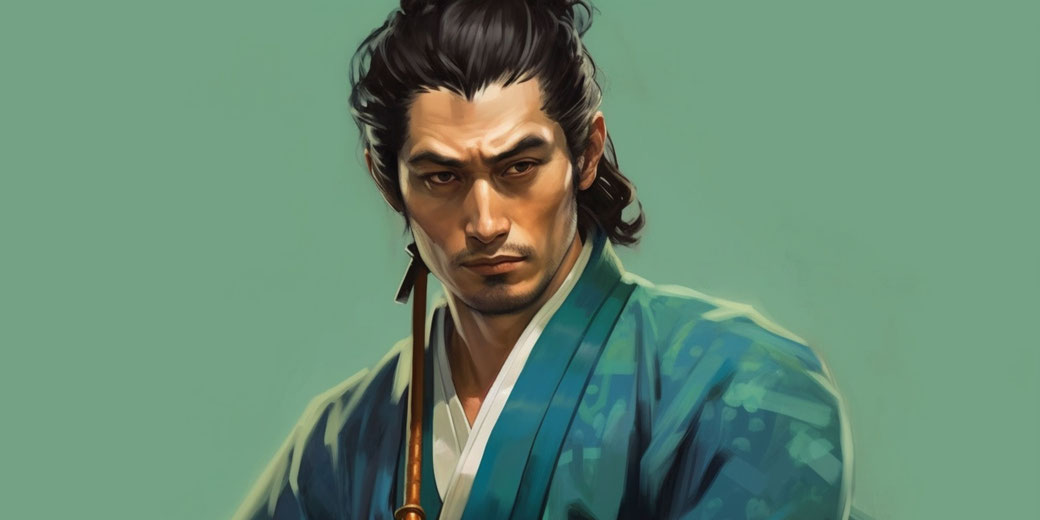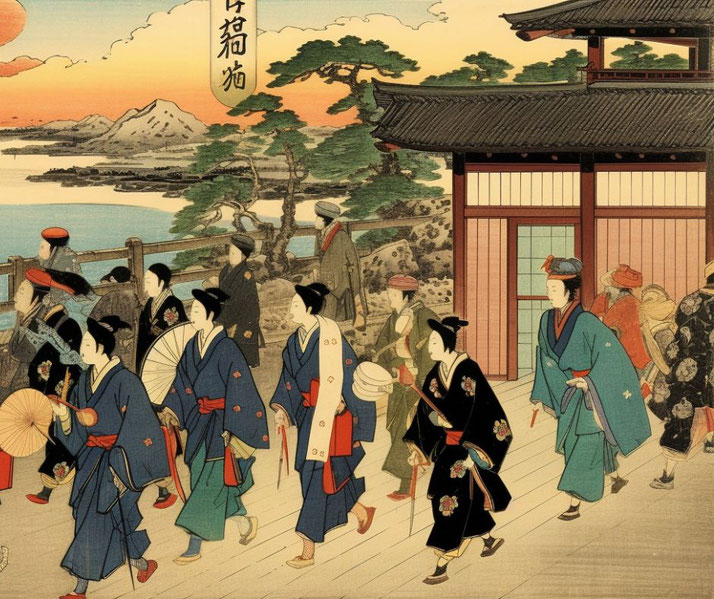The Shinsengumi: Unraveling the mysteries of Japan's famed warrior group

In Japanese history, the Shinsengumi stand as one of the most intriguing entities, a group bathed in both glory and controversy.
They were the protectors of Kyoto during a time of tumultuous change, the last line of defense for a feudal society on the brink of a seismic shift towards modernity.
The late Edo period, also known as the Bakumatsu period (1853-1868), was a time of internal conflict, diplomatic challenges, and deep-seated societal unrest.
Japan was grappling with the increasing pressure of Western influence, the disintegration of the established Shogunate, and the emergence of new political and social ideologies.
Amidst this chaos, in 1863, the Shinsengumi – or "Newly Selected Corps" – was formed. This special police force, loyal to the Shogun, was tasked with the mighty responsibility of maintaining order in the imperial capital, Kyoto.
Why the Sinsengumi was formed
The year 1863 found Japan in the throes of an identity crisis. The arrival of Commodore Matthew Perry's "Black Ships" in 1853 had shattered the nation's isolationist policy, the Sakoku, opening its doors to Western influence and setting the stage for significant societal upheaval.
The Shogunate, already facing internal dissatisfaction, was further weakened by its inability to successfully rebuff foreign powers, leading to the rise of a potent political faction advocating for the imperial restoration: the sonnō jōi ("Revere the Emperor, Expel the Barbarians").
In this context of upheaval and disorder, Kyoto, the imperial capital, became a hotbed of political machinations and often violent conflicts.
To restore order in the city, the Shogunate decided to form a special police force. The early seeds of the Shinsengumi were planted when Kiyokawa Hachirō, a pro-imperial rōnin, organized a group of swordsmen, primarily from the rural Mito and Chōshū domains, to serve this purpose.
However, he would eventually be revealed as a radical sonnō jōi supporter, leading to his expulsion from the group and the emergence of a new leadership structure.
The remaining group, mostly composed of men with low social standing, including ronin and peasant farmers, was taken over by Serizawa Kamo, Niimi Nishiki, and Kondō Isami.
These leaders would guide the transformation of the group into the Shinsengumi, meaning the "Newly Selected Corps."
Their mandate was to patrol the streets of Kyoto, suppress the sonnō jōi revolutionaries, and maintain the Shogunate's control.
What's remarkable about the Shinsengumi's establishment is how these men from humble backgrounds managed to overcome the rigid social hierarchies of the period.
The samurai class system was still very much in place during the Edo period, and for low-ranking samurai and ronin to be given such a significant task was unprecedented.
They were not only entrusted with maintaining order but also safeguarding the stability of the Shogunate.

How the Sinsengumi operated
As an organization, the Shinsengumi was as complex as the era it was birthed from, with a roster of members as diverse as they were skilled.
Comprising mostly of lower-class samurai and ronin - masterless samurai - the group was home to a variety of individuals, each carrying a unique story, yet united under the banner of the Shinsengumi.
The leadership of the Shinsengumi changed over time due to various internal conflicts and political dynamics.
Initially, the group was led by three men: Serizawa Kamo, Niimi Nishiki, and Kondō Isami.
Serizawa, a skilled and charismatic yet unpredictable leader, along with Niimi, were eventually purged from the group due to their erratic behavior and disregard for civilian safety.
This left Kondō Isami, a respected swordsman and disciplinarian, as the sole leader.
Kondō, along with his right-hand man Hijikata Toshizō, who served as the group's vice-commander and was known for his strategic acumen, would go on to shape the Shinsengumi into an effective policing force.
Other key figures in the group included Okita Sōji, the captain of the first unit and one of the best swordsmen in the Shinsengumi.
Nagakura Shinpachi, the captain of the second unit, and Harada Sanosuke, the tenth unit's captain, were other prominent members known for their martial skills.
There was also Saitō Hajime, who, despite his quiet demeanor, was one of the most skilled members of the group.
These men, along with others, formed the backbone of the Shinsengumi and were instrumental in many of its operations and activities.
Interestingly, the group was highly structured, with a strict hierarchy and a code of conduct known as the Kyokuchū Hatto, which regulated everything from uniform regulations to behavior both within and outside the group.
Violation of these regulations, which included clauses on loyalty to the Shogun and prohibition of private fights, could result in seppuku, a form of ritual suicide.
The dramatic events involving the Shinsengumi
The Shinsengumi's active service was a relatively short but impactful period marked by numerous key events and activities.
These events, both violent and diplomatic, shaped the course of the Shinsengumi's existence and deeply influenced the sociopolitical landscape of the Bakumatsu period.
Arguably, the most significant event associated with the Shinsengumi is the Ikedaya Incident in 1864.
This was a key turning point in the group's history, establishing its reputation as a potent force.
The incident was an orchestrated crackdown on the anti-Shogunate Choshu-aligned, sonnō jōi samurai planning to burn down Kyoto and kidnap the emperor.
The Shinsengumi's intervention resulted in the thwarting of these plans, saving Kyoto from potential disaster.
The incident greatly enhanced the Shinsengumi's prestige and earned them the Shogunate's recognition, leading to an increase in their numbers and influence.
The Shinsengumi were also involved in various policing activities aimed at maintaining order in Kyoto.
These duties included patrols, investigations, and direct conflict engagement against the rōnin and various anti-Shogunate factions causing disturbances in the city.
They were also tasked with providing security during the Emperor's visits to Kyoto's imperial palace.
Another notable event was the Aburanokōji Incident in 1865. A Shinsengumi member, Takeda Kanryūsai, was accused of spying for the enemy Choshu domain.
The punishment meted out was seppuku, underlining the seriousness with which the Shinsengumi regarded any form of betrayal.
In the political landscape of the time, the Shinsengumi also played a part in supporting the Aizu and Satsuma domains, both allies of the Shogunate, in their opposition against the Choshu domain.
This participation underlined the Shinsengumi's deep involvement in the political struggles of the era.
Growing tensions within the organisation
As the Shinsengumi expanded its influence and power, it also experienced its fair share of internal conflicts and changes.
These upheavals, mainly triggered by power struggles, differing ideologies, and personal grievances, shaped the group's dynamics and eventual destiny.
The first major conflict occurred early in the Shinsengumi's existence, revolving around two of its original leaders, Serizawa Kamo and Kondō Isami.
Serizawa, despite his undeniable skill and leadership capabilities, was known for his erratic behavior and disregard for the safety of civilians.
His actions, along with those of his close ally Niimi Nishiki, started causing serious concerns within the group and among their Shogunate sponsors.
The situation reached a climax when Kondō Isami, along with Hijikata Toshizō and other members, assassinated Serizawa and Niimi in 1863.
This coup shifted the group's leadership solely to Kondō, marking a significant change in the Shinsengumi's leadership and internal dynamics.
Further strains developed within the group due to the strict code of conduct, the Kyokuchū Hatto.
This code imposed severe penalties, including seppuku, for violations of its rules. These strict regulations resulted in a tense atmosphere within the group, leading to instances of desertion and infighting.
One notable episode of internal conflict was the dispute with Itō Kashitarō, a highly educated samurai and advisor to Kondō.
Itō, who had ideological differences with Kondō and Hijikata, eventually defected from the Shinsengumi in 1867 with several other members to form a rival group, the Goryō Eji.
However, he was assassinated shortly after, believed to be at the hands of the Shinsengumi.
Finally, the political upheavals of the era also echoed within the Shinsengumi. As the Shogunate's grip on power waned, some members found themselves questioning their loyalties and the group's future.
These doubts further exacerbated the group's internal tensions, setting the stage for the tumultuous period that followed.
Why the Sinsengumi came to an end
The fate of the Shinsengumi was intricately tied to the Shogunate they served, so as the Tokugawa Shogunate's power waned, so too did the power and influence of the Shinsengumi.
The year 1868 marked the beginning of the end for this samurai police force, as the Boshin War – a civil war fought between the pro-imperial and pro-shogunate forces – signaled the death knell for the Shogunate and, by extension, the Shinsengumi.
With the start of the Boshin War, the Shinsengumi found themselves on the losing side of history.
They fought valiantly alongside the remnants of the Shogunate forces, participating in key battles such as the Battle of Toba-Fushimi.
Despite their efforts, the pro-imperial forces proved too strong, and the Shogunate forces, including the Shinsengumi, were forced to retreat.
Their leader, Kondō Isami, was captured in the Battle of Kōshū-Katsunuma and subsequently executed by the new Meiji government.
The loss of Kondō was a significant blow to the already beleaguered Shinsengumi, both in terms of morale and leadership.
Following Kondō's execution, the remaining Shinsengumi members, under the leadership of Hijikata Toshizō, retreated north to Aizu.
There, they regrouped and continued the fight, taking part in the Battle of Aizu. After a grueling series of engagements, they again retreated further north to the island of Hokkaido.
Hijikata organized the remaining members into a new group called the Republic of Ezo, attempting to establish an independent domain in Hokkaido with the surviving Shogunate forces.
The group made its final stand against the imperial forces in the Battle of Hakodate.
Their resistance, however, was futile. Hijikata fell in battle, and the Republic of Ezo was swiftly disbanded after their defeat.
With the fall of Hijikata and the dissolution of the Republic of Ezo, the Shinsengumi officially ceased to exist.
The surviving members scattered, with some integrating into the new Meiji society and others vanishing into the annals of history.
How the Sinsengumi are remembered today
In historical discourse, the Shinsengumi are seen as symbols of loyalty and honor, the last true samurai who upheld the principles of bushido during the societal upheaval of the late Edo period.
They have been romanticized as tragic heroes, caught in the crossfire of a changing era.
At the same time, their actions and methods, which sometimes involved ruthless enforcement of law and order, have also been criticized.
This dual view adds a layer of complexity to their historical portrayal.
Culturally, the Shinsengumi have had a significant influence on literature, manga, anime, films, and even video games.
Stories and characters inspired by the Shinsengumi and its members are common in these mediums.
For instance, the popular anime and manga series "Rurouni Kenshin" and "Gintama" feature characters inspired by the Shinsengumi, while the group itself is the focus of series such as "Shinsengumi!" and "Hakuoki".
The Shinsengumi's story has been told and retold in these various forms, each time providing fresh interpretations and perspectives, thus keeping their legacy alive.
Moreover, the influence of the Shinsengumi is not just limited to fictional portrayals.
In modern Kyoto, the Shinsengumi are commemorated in the form of memorials, statues, and festivals.
The Mibu Temple in Kyoto, where the Shinsengumi were based, has become a site of historical interest for those eager to explore the group's history.
What do you need help with?
Download ready-to-use digital learning resources
Copyright © History Skills 2014-2025.
Contact via email
With the exception of links to external sites, some historical sources and extracts from specific publications, all content on this website is copyrighted by History Skills. This content may not be copied, republished or redistributed without written permission from the website creator. Please use the Contact page to obtain relevant permission.





